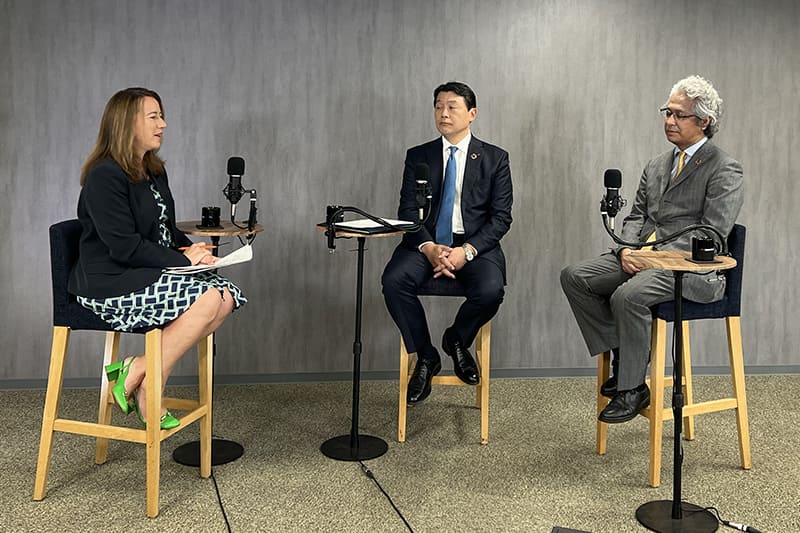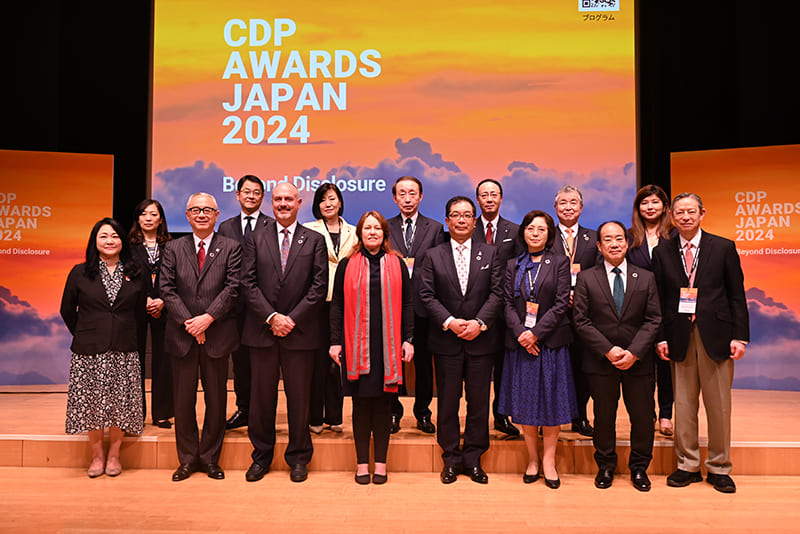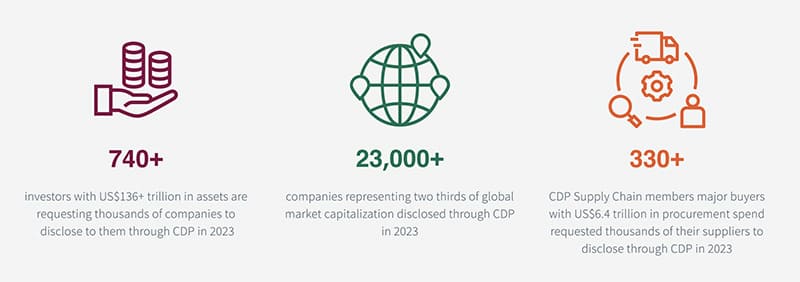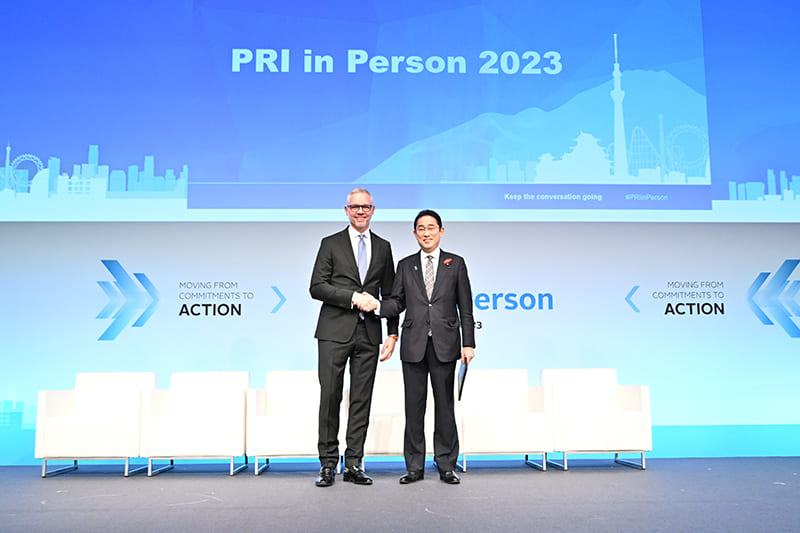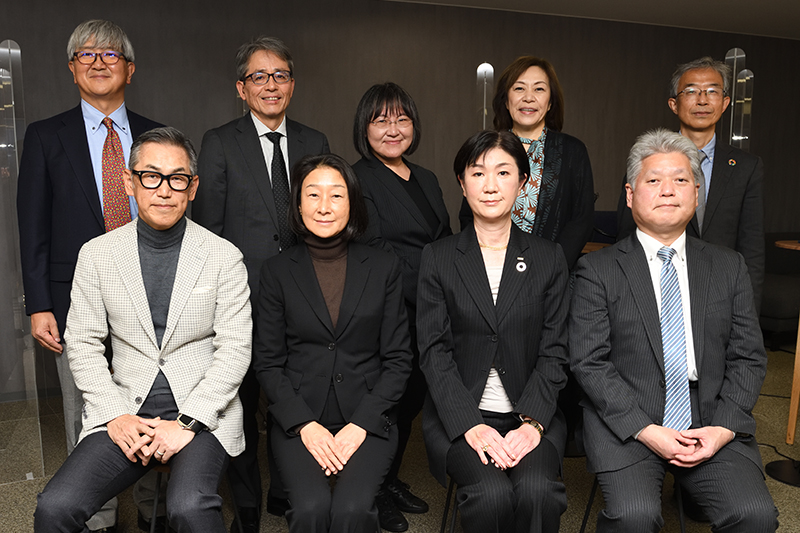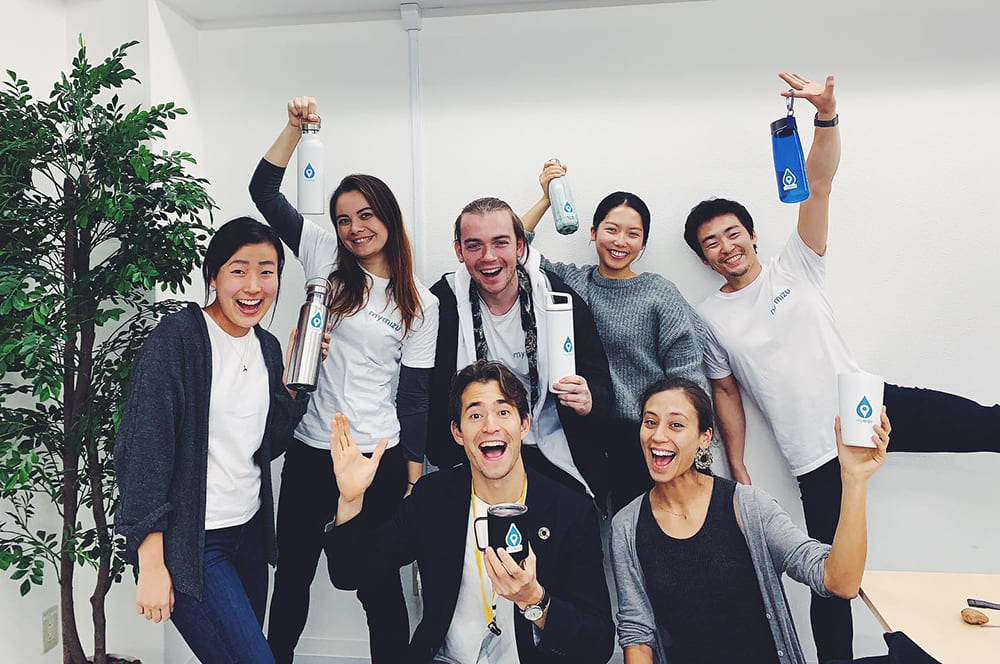February 02, 2024
Symposium: How to keep water clean and plentiful
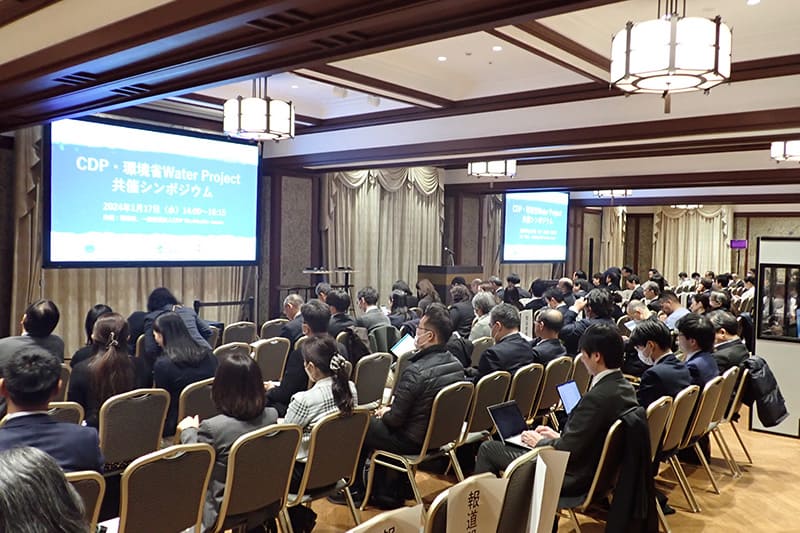
Amid increasing concern over global warming and biodiversity, corporate experts and local administrators gathered to discuss issues concerning healthy water circulation on Jan. 17 in Tokyo.
The symposium was sponsored by the Environment Ministry and CDP, a London-based nonprofit that runs the world’s environmental disclosure system for companies, cities, states and regions.
The event kicked off with a statement by Motome Takisawa, state minister of the environment, who said that controlling water risks is becoming an increasingly important topic for companies and investors, with global warming causing more serious floods and droughts and affecting people’s daily lives and companies’ operations.
“We will build locally rooted models for good water circulation through protecting biodiversity and revitalizing regions,” Takisawa said.
Kiyohiko Suzuki, director of the ministry’s office of pollution control, explained the ministry’s Water Project, which aims to promote public-private cooperation on water conservation.
“We have recently put a lot of effort into creating good water circulation and aquatic environments. For that purpose, we support water conservation based on local activities and culture as well as regional revitalization,” Suzuki said.
Last year, the ministry selected three model projects. One in the Okinawa village of Ogimi aims to protect water resources in the area, which is famed for its rich wildlife, including local species. Another in Hiroshima aims to conserve and manage groundwater essential for brewing specialty sake. The third, in Nagano Prefecture, aims to preserve the uppermost part of the Shinano River and historical information on water resources that are vital for the region’s power generation and irrigation and people’s daily lives.
Suzuki said the ministry designates sites for biodiversity conservation that are owned by companies, private organizations, individuals and municipal governments and registers them as “other effective area-based conservation measures” (OECMs) as part of a new global approach to conservation. Unlike national parks, which are protected by the central government and serve mainly to preserve scenery and habitats for wildlife including endangered species, OECMs are all sorts of sites that deliver biodiversity — for example, privately owned woods and forests, regional parks, golf courses, ski resorts, riverbanks, bird sanctuaries and biotopes.
“The purpose is to conserve various types of nature, even if they are not protected areas,” Suzuki said, adding that the ministry has so far designated 122 such sites across the nation.

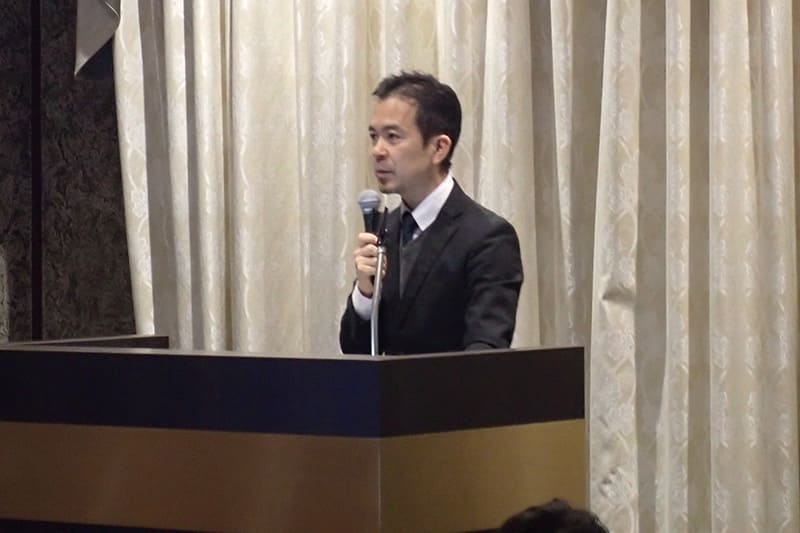
Plastic nasties
He also mentioned intergovernmental negotiations against plastic pollution in the ocean — increasingly in focus because it harms marine biodiversity. So far, Japan accounts for 48% of all plastic from Asian nations in the ocean, he said.
In addition, the problem of the PFAS “forever chemicals” has gained stronger global attention in recent years, he said. They are widely used in consumer and industrial products and are now found in water and air across the world, with some thought to be harmful for human and animal health.
Aisha Stenning, program manager for plastics at the Ellen MacArthur Foundation, a U.K.-based nonprofit for promoting a circular economy, warned of a possible water crisis: The global demand for fresh water is expected to far exceed the available resources by 2030 if we maintain business as usual. “We need to dramatically change the way water is used, managed and shared,” she said in her presentation.
To avoid this crisis, regional governments should accelerate transitions to circular economies, in which materials do not go to waste and nature renews itself, she said. In such economies, products and materials are circulated through maintenance, reuse, refurbishment, recycling, remanufacturing and composting, with water also recycled and reused.
In the next speech, Jasmine Chilton, the plastics engagement manager for CDP, discussed recent progress in global disclosure of plastic waste and pollution.
She said many global voluntary initiatives support corporate disclosure on plastics, such as CDP, the Ellen MacArthur Foundation, the Taskforce on Nature-related Financial Disclosures (TNFD) — a U.N.-supported international initiative to provide frameworks for disclosing and managing nature-related risks and impacts — and WWF, a global organization for protecting wildlife, especially endangered species.
Last year, CDP for the first time asked about 7,000 companies around the world to disclose their plastics-related information. Of the 3,000 that responded, more than 600 are based in Japan, Chilton said.
The Ellen MacArthur Foundation launched its Global Commitment in 2018 to stop plastic packaging from becoming waste, and has so far united more than 1,000 organizations that cover 20% of the packaging market, she said. TNFD added plastics to its final disclosure recommendations released in September. WWF has a disclosure tool for companies that was launched with a handful of major companies.
Policymakers are also taking action on plastic waste, Chilton continued. At the 2022 U.N. Environment Assembly, 175 nations agreed to develop a treaty for plastic pollution by 2024. It will be a legally binding instrument focusing on production, disposal and marine environments.
Also, the European Sustainability Reporting Standards that were adopted in July cover a wide range of environmental topics. “They mentioned that companies should disclose the pollutants that they release in their own operations, as well as some microplastics that are generated or used in their own operations and during their product life cycles,” she said.
In the financial sector, the United Nations Environment Programme Finance Initiative helps the financial industry address environmental issues. The UNEP has released a mapping of the global plastics value chain that shows there are risks at every stage. “Plastic is not just about packaging, and it is not just a concern of the users. It’s also a concern for the upstream value chain stages, plastic production and the downstream waste managers and recyclers,” Chilton said.
Members of the Dutch Association of Investors for Sustainable Development, an independent lobbying organization, have signed a statement urging companies to do more to reduce plastic packaging. They have also published Plastic Perspectives, an overview of the plastic footprints and ambitions of European and U.K. retailers. “They are showing that actual plastic is growing, and we really think they’re a great example of investors integrating plastics into their investment decisions,” she said.
Another example of investor action is Green Century Capital Management, which has used shareholder recommendations to encourage companies to take steps to reduce their plastic footprints, she said.
Osaka action
Among examples of action by local governments, Osaka Prefecture has outlined plans to reduce plastic pollution in the ocean.
Osaka, which is one of the country’s busiest commercial cities and also faces Osaka Bay, in June 2019 hosted the Group of 20 summit, at which one of the key topics was marine plastic waste. The prefecture unveiled the “Osaka Blue Ocean Vision” policy and pledged it would reduce the flow of plastic waste into Osaka Bay to zero by 2050. Toward achieving that goal, it set an interim target of cutting plastic waste in half by 2030.
According to the prefectural government, more than 80% of garbage floating on the bay is plastic, including PET bottles, food packages and plastic bags, and about 70% of the waste on the bay and the adjacent Seto Inland Sea comes from land. “So, what’s important is not to use disposable bags, cutlery and PET bottles as much as possible, and if we use them, we have to collect and recycle them,” said Manabu Hashida, a senior official in charge of environment protection at Osaka Prefectural Government.
In 2019, Osaka pledged to stop plastic waste by reducing disposable plastics, promoting the “3Rs” of reduce, reuse and recycle, avoiding litter and using alternatives. As of December, a total of 108 cities, villages, labor unions, companies, schools and other groups had joined the pledge, Hashida said.
As part of its plans, Osaka has started a campaign for people to carry their own water bottles instead of PET bottles. At city halls, schools, other public facilities and tourist spots, the government has installed water fountains so people can refill their bottles for free.
Litter from truck drivers has been a big issue, so Osaka is cooperating with its truckers’ association, putting up anti-littering posters and distributing trash boxes that can be placed beside the driver’s seat.
In October 2021, Osaka also created a website with a map showing stores and restaurants that let customers take home food and drinks using their own containers. As of last December, the map showed about 752 restaurants, retailers and water refilling stations.
It also hosted events to help Osakans better understand the problem of marine plastic waste ahead of Expo 2025. One at a major shopping mall was geared toward helping them as well as tourists reduce, reuse and recycle plastic bottles and packages, while a game-like event was held to help motivate younger generations to collect litter.
Another plan is to revive and foster an ecosystem, including seaweed, marine algae and tidal flats, along the coast of Osaka Bay that can contribute to carbon neutrality by fiscal 2050, Hashida said.

Disclosures on nature
In the next presentation, Hirotaka Hideshima, executive adviser to the Norinchukin Bank and a member of the TNFD, talked about recent developments in global corporate disclosure requirements related to nature, including marine life.
The TNFD in September published its final recommendations on a framework for nature-related risk management and disclosures to prompt corporations and financial institutions to take steps to report their impacts.
Its task force released 14 recommendations for companies to disclose nature-related risks and opportunities. Eleven are based on recommendations it already had released in 2017, covering four areas: governance, strategy, risk management, and metrics and targets.
Hideshima stressed that “planetary boundaries” — processes that are critical for maintaining the Earth’s stability — such as genetic diversity and biochemical flows of nitrogen and phosphorus already have reached high-risk levels. Also, the top global risks expected 10 years from now rank damage to biodiversity in third place.
He said the TNFD’s final recommendations included five conditions for when companies need to start disclosing nature-related information to the TNFD. First is that the firms have already started to disclose such information on part of their business. Second is that they plan to widen the range of disclosures. The others are that they plan to close the gap with a new disclosure plan, that their management board has approved such disclosures, and that they have registered their commitment with the TNFD.
“The TNFD’s way of thinking is that it is OK for companies to start disclosing partially,” Hideshima said.
Growing ‘natural capital’
In a panel discussion, corporate experts on environmental management discussed what they have done for their “natural capital” — natural resources that benefit people — and what they plan to do in the future.
Hideshima said Norinchukin Bank is greatly interested in its corporate borrowers’ and investees’ impacts on nature, since the bank manages money that come from savings by farmers and fishers, whose work is closely connected to the environment. “We always hoped that our borrowers’ businesses did not negatively affect nature, but we did not have any ways to check that,” Hideshima said. But now checking is much easier, thanks to the TNFD’s disclosure framework.
He pointed out that some sectors are greatly dependent on water resources or have significant impacts, such as semiconductor makers and power companies.
Ryosuke Mizouchi, senior executive officer and director in charge of “creating shared value” for Kirin Holdings, said the beverage maker aims to build a circular economy by developing a recycling technology that converts plastic waste into new plastics by changing its chemical structure. “We are currently doing research and development to commercialize the technology by 2027,” Mizouchi said.
Two-thirds of Kirin’s profits come from beer and other beverages, making the company significantly dependent on water. About 95% of its plastics are PET bottles, and about 40% of those are recycled. But the recycling currently employs mechanical processing and can only recycle bottles a few times, he said.
Another panelist, Uchu Mukai, the chief environmental impact officer for Lixil Corp., said one of its business priorities is water conservation and environmental sustainability worldwide, as it makes home products like showers and bathrooms and has 55,000 employees in more than 150 countries. It is pursuing water sustainability under the Lixil Environmental Vision 2050.
The company aims to use water efficiently at its own production plants. In particular, it is improving water efficiency at 77 of its factories that have high water stresses, rated using an online WWF tool that helps companies assess their water risks.
For its customers, the company is developing products like toilets and shower heads that use less water. It is also developing a shower system called Everstream that can recycle water at home through filters and a sterilization process.
“Saving water is important for conserving not just water but also the energy needed to clean or warm it, so it also reduces greenhouse gases,” Mukai said.

Corporate cooperation

Kirin’s Mizouchi emphasized the importance of cooperating with partners in companies’ value chains. In Kirin’s case, it cooperates with farmers of barley, hops, black tea and coffee so they can use rain or green water to grow their products. For some black tea farmers in Sri Lanka, it developed a tool with a nongovernmental organization, the Rainforest Alliance, to help them practice regenerative farming — that is, use nature-friendly farming to protect the soil, foster biodiversity in fields and revive the ecosystem. “We are paying attention to regenerative farming because it contributes to ESG (environmental, social and governance issues) in an integrated way by reducing greenhouse gases, improving efficient water usage, avoiding floods and protecting human rights, all at the same time,” Mizouchi said.
As for steps related to the TNFD, he said the company has disclosed data on factory water in Australia, tea leaves in Sri Lanka and vineyards in Japan, based on the TNFD’s “locate, evaluate, access, prepare” (LEAP) approach.
The beverage maker also used the TNFD’s analysis framework for its group brewer in Fort Collins, Colorado, which has high water stress. “To manage watersheds, it is important to do it with value chain participants and their communities,” Mizouchi said, adding that it is important to not only disclose data based on the framework, but also identify the risks and take action.
At the end of the discussion, panelists reiterated the importance of cooperating with other businesses. “There is much more to do to tackle climate change, but we can’t do much alone on water issues and plastic waste. I believe we can do a bigger job by making alliances with other business sectors,” Lixil’s Mukai said.
Other panelists said Japan can do more to take the initiative to build a circular economy. “We have to show the world that Japan can lead the way in building a circular economy,” Mizouchi said, noting that Japan currently collects 90% of its used PET bottles, compared to 40% in Europe and 10% in the United States. “I want to encourage the audience to follow these two companies as the models, and take initiative in corporate disclosure and actions,” Norinchukin’s Hideshima said.
In closing, Takejiro Sueyoshi, special adviser to CDP Worldwide-Japan, said the global community needs to understand the root causes of the destruction of nature. “Our business, economic and social models — our way of living itself — have gone beyond the planet’s limits without our realizing it, after we drove so hard to achieve material prosperity,” he said. What we must do, he continued, is to return to within the boundaries and build a sustainable society. “When we work on planetary issues, we should not forget that the root of all the problems is the same, and our discussions should be based on a thorough understanding of that,” he said.
Aiming to highlight issues related to a sustainable society, The Japan Times gave its support to this event by becoming a media sponsor.

